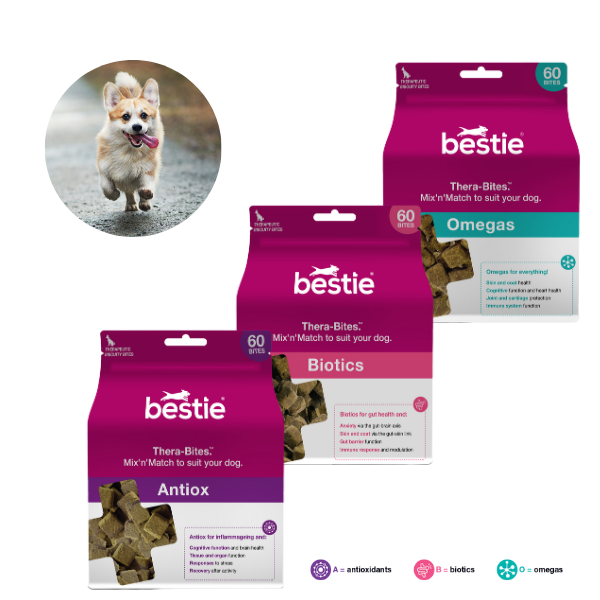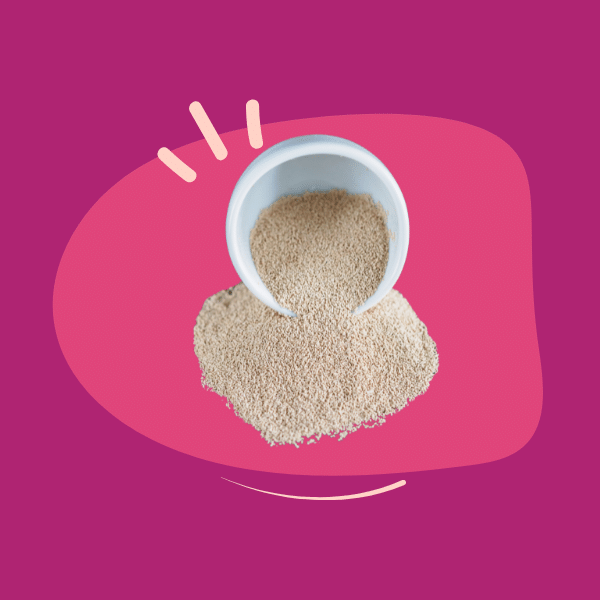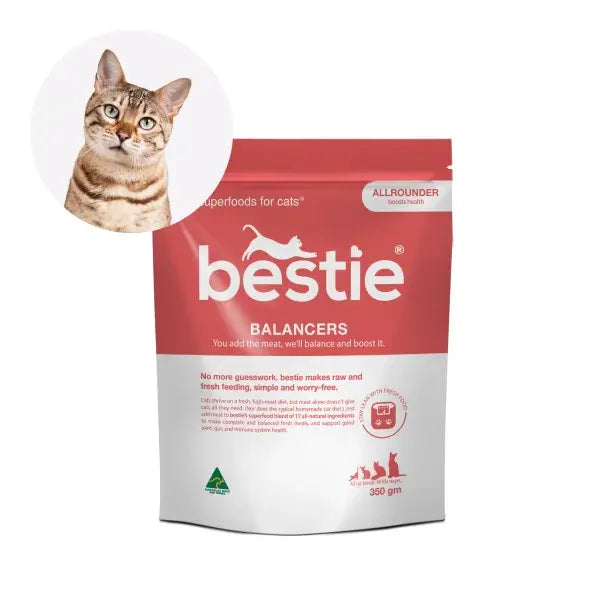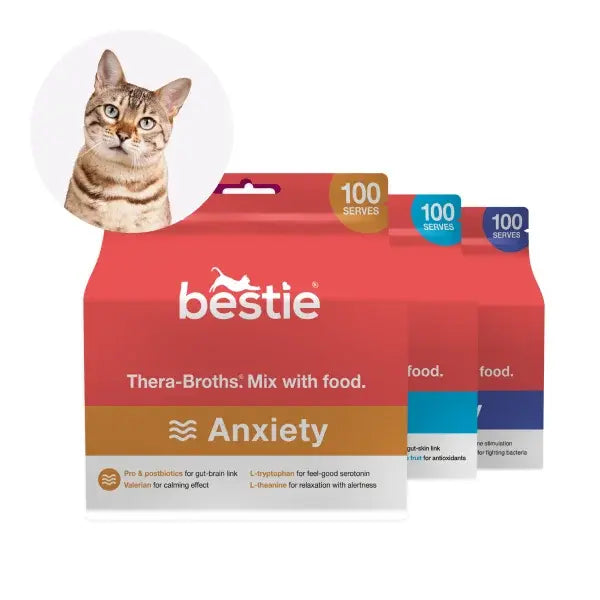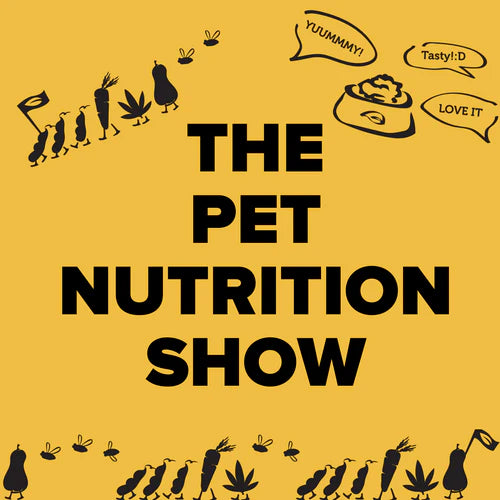When you think of Indonesia, we're betting it's more visions of tropical beaches with great surf...not innovation in pet food. But this week, we head to Indonesia to talk with the founder of Indonesian cat food manufacturer, Pawprints.
Dr Anna talks with Jackie Sulistyo about her journey into the pet nutrition industry, inspired by her picky cat Leo and the lack of pet food variety in Indonesia during the COVID-19 pandemic.
Jackie explains how Pawprints leverages novel insect protein from black soldier flies for its cat food, and explains the benefits for digestion and allergies. The episode also explores pet ownership behaviours, sustainability concerns, and the importance of local pet food production and ingredients in Indonesia. Finally, Jackie shares Pawprints' future plans for product expansion and team growth.
Dr Anna also answers a question even you may have asked yourself: can your dog eat parsley???
00:00 Welcome to the Pet Nutrition Show!
00:43 Weekly Pet Q&A: Is Parsley Safe for Dogs?
01:59 Exclusive Interview: Jackie Sulistyo on Sustainable Cat Food in Indonesia
04:45 The Rise of Pet Ownership in Indonesia
07:13 Innovating with Insect Protein: Pawprints' Journey
11:04 Local Ingredients and Pet Food Production in Indonesia
15:45 Sustainability and Consumer Preferences in Indonesia
17:02 Marketing Strategies and Future Plans for Pawprints
20:10 Closing Thoughts and How to Connect with Pawprints
You can listen on Apple podcasts here.
Have a listen to the show, but if you’re more of a reader, here's the transcript:
Note: This is an automatically generated transcript and has not been corrected for typos.
[00:00:00] INTRO: This is the Pet Nutrition Show with Amanda and Dr. Anna.
[00:00:07] ANNA: Hello and welcome to the Pet Nutrition Show, the show where we talk all things pet health, pet nutrition, and sustainability. Now, I'm Dr. Anna. Normally at this point I say, I'm Dr. Anna and this is my co host Amanda Falconer, but Amanda actually is away at the moment.
[00:00:23] ANNA: So for today's episode, it's just me, but no matter, I'll be interviewing Jackie Jackie Sulistyo, who is the head or founder, one of the founders of Pawprints, which is a cat food company in Indonesia with the lofty goal of bringing sustainable cat food to Indonesian cats. So, we'll hear from Jackie in a moment, but before that, we have, of course, our usual weekly Q& A.
[00:00:50] INTRO: Pet Q& A, where we answer what you're wondering about food, moods,
[00:00:55] ANNA: and
[00:00:56] INTRO: poos.
[00:00:57] ANNA: And today's question was, can I give [00:01:00] parsley to my dogs? And this came up and it caught me by surprise, actually, because parsley is in all sorts of formulations. And the short answer is yes, but what was throwing people and why the question came about is when you Google Parsi, it comes up as highly toxic for your dog.
[00:01:17] ANNA: And that's because it's got a particular compound in it that when consumed in large amounts actually is toxic. However, for the most part Parsi in moderation has lots of good benefits in terms of freshening breath, antioxidants. And all sorts of bioactive compounds. So, as long as you don't give your dog a truckload of parsley, kilos worth or enough to fill their bowl, then they'll be perfectly all right.
[00:01:49] ANNA: And for anybody who's interested in parsley, the curly leaf parsley apparently doesn't have this particular compound in, but the flat leaf does. So there you go, all about parsley. And [00:02:00] now we'll head on to our interview with Jackie. Show, and thank you for giving up your public holiday to come and talk to us today.
[00:02:07] ANNA: So, to kick things off, tell me about yourself and tell me about pawprints and how your journey into the pet nutrition industry started.
[00:02:17] JACKIE: Yeah. Thank you so much, Anna, for having me on the show. I'm happy to, you know, take my public holiday today. I'm Jackie as founder and CEO at pawprints. com. Group and one of the new brands that we've recently pop prints here in Indonesia.
[00:02:33] JACKIE: So, my inspiration was really my cat, who is my latest pet, back in 2019. He was a cat from a local shelter, and, you know, during that time in 2019, 2020, if anyone still recalls, it was the COVID 19 pandemic, and so, of course, we were both stuck at home. Little did I know that I had adopted a cat who was very picky with his food.
[00:02:59] JACKIE: So, we [00:03:00] learned through, you know, many trials, experimenting, trying different foods, and naturally, I guess, my curiosity on, you know, what different ingredients meant, and also, the benefits, you know, why, especially my, uh, my cat Leo, he did like this one, or didn't like this other one. And during that time, I also moved back to Indonesia.
[00:03:20] JACKIE: And so at that time, I was really seeing the market here and seeing that there was just a space or lack thereof in terms of variety for pet food. And I guess, Yeah, that's really the inspiration behind our latest brand, Pawprints.
[00:03:37] ANNA: Lucky Leo. Yes, I bet you spent a lot of time working your way through brands.
[00:03:42] ANNA: Cats are really quite tricky in that regard. They're incredibly picky, aren't they?
[00:03:47] JACKIE: Yes. Yes, they are.
[00:03:49] ANNA: So cats then, are they a big thing? You mentioned the cat and you mentioned you got a cat from a shelter in Indonesia. Is Indonesia mainly a cat place or is it? But do you have a good chunk of dogs [00:04:00] as well?
[00:04:00] JACKIE: Yeah, good question. So because Indonesia is predominantly a Muslim country and population, there is a larger preference for cats versus dogs. But in terms of pet ownership, actually, in Indonesia as a whole, I believe fish actually make up a large part of the population. So fish, from latest information in 2020, 2022, make up about 70 percent of the population, actually, in terms of pet ownership.
[00:04:30] JACKIE: No way! Where cats is closer to about 20 percent and dogs is about 5%. So you can see there, there's actually a big gap or exponential difference. in terms of cats versus dogs here.
[00:04:45] ANNA: Absolutely. And is that pet ownership growing in Indonesia and specifically in cats?
[00:04:51] JACKIE: You know, this I think is a trend globally, but the pandemic and COVID 19 really fueled pet adoption and [00:05:00] ownership in most countries.
[00:05:01] JACKIE: So similarly in Indonesia, that really fueled the growth. And in the past five years, we've been seeing double digit growth in the pet market space. by sales value. And interestingly enough, with cat ownership, households typically have on average maybe two or three, maybe even five cats per house, where in comparison to dogs who take up, of course, more space and also energy, the typical ownership for dogs is maybe about one or two per household.
[00:05:31] ANNA: Wow. Five cats in your house. That's a lot, isn't it? So, thinking still on Indonesia then. And Indonesian cat owners, are they typically all buying commercial diets or is there a big Part of that ownership group that is still home feeding.
[00:05:49] JACKIE: Yeah, interestingly enough, you know, after really looking at the market and understanding consumer behavior here in terms of pet food, we're seeing that cats, because they are [00:06:00] obligate carnivores, there's already this tendency and behavior to buy pet food.
[00:06:05] JACKIE: Preparing, of course, home meals, buying meats and fresh produce is, of course, more time consuming and is also costly. So for cat owners, there is already this awareness to be purchasing pet food, where actually for dog It's quite a contrast. We see a mix of both. This will depend on their household and socioeconomic background.
[00:06:34] JACKIE: So we're seeing in larger cities, metropolitan cities, such as Jakarta, for dog owners, there is a growing trend for home fed raw food and slow cooked diets. So typically in a household with dogs, if you already have being food prepared for the family, they would then set aside food for their dogs. So there is already that separate behavior, but again, [00:07:00] this will depend on their socioeconomic background.
[00:07:03] ANNA: Hmm, that's very interesting. I, I made the assumption that, uh, many cat owners were, were still feeding their cats scraps. Well, there you go. So, on to paw prints now. Cats are notoriously fussy, as you've, you've mentioned. So, how did you go? Launching your cat food in Indonesia in, in your local markets and what were your early goals for paw prints?
[00:07:31] JACKIE: Yeah, for paw prints, we really saw from consumer demand, most of their issues or challenges with pet food existing in the market, which tend to be Just digestive issues, sensitivities, and as well as allergies. And so with that bearing in mind, we were looking to ways to provide them alternative solutions for those issues.
[00:07:57] JACKIE: And so I came about [00:08:00] insect protein, or really the use of black soldier fly. in pet food through my research. And interestingly enough, because insects are a novel protein with low tendency for any allergies, um, and very high in terms of nutrition, this is something that we really leaned towards and experimented with.
[00:08:22] JACKIE: And so for us, we wanted to ensure that, of course, palatability is very important when it comes to these picky cats. And so we did go through a process of trial and error once again, you know, in terms of many iterations of formulating and then really having to look into the market of the popular brands.
[00:08:43] JACKIE: And we took definitely some time, um, I think it was closer to about 10 months to really get that perfect formula for us and testing them out against these other benchmarks. So we wanted to really make sure that we understood where we stood, not only [00:09:00] nutritionally, but also in terms of taste wise.
[00:09:02] ANNA: And what was the feedback from the local Indonesian cats to, to Insect?
[00:09:07] ANNA: Because you, you would have been one of the first brands in Indonesia to launch with Insect, wouldn't you? If not the first brand.
[00:09:13] JACKIE: Yes, that's right. I think for pet food, we are one of the first. Not that I know of any other brands using insect in their pet food. Interestingly enough as well, I think there has been a growing trend in terms of farming black soldier flies specifically here in Indonesia.
[00:09:29] JACKIE: We are a large agricultural country and there are a lot of organic waste, including our production of palm. And so we're seeing that, you know, BSF farming is a solution in terms of reduction of organic and food waste. In several parts throughout the country, there is some of this BSF farm. So for those who are within the industry, they already have a receptability towards using insect and insect protein.
[00:09:57] JACKIE: However, of course, not all [00:10:00] consumers have this awareness, right? So, it was really for us to show the benefits. of consuming insect protein for pets. And overwhelmingly enough, what we've been seeing is that many of those issues that cats were having in terms of digestibility was really helped by consuming the BSF.
[00:10:20] JACKIE: And so a lot of the, our customers, you know, come back to us and say that previously with all the, You know, issues on and off with diarrhea and so on, you know, they're being able to manage stability in terms of their cat's diet. And naturally, because RBSF is also fed on, uh, palm waste, this is very high in omega 6.
[00:10:39] JACKIE: And of course, the omega 6 is really beneficial for hair and skin growth.
[00:10:43] ANNA: Hmm. Palm kernels are great, uh, feedstock for BSF. Actually, some suppliers actually, or BSF suppliers actually purchase palm kernels. Having it on your doorstep with potentially a local supplier must be great for the Indonesian [00:11:00] marketers as a whole, having that local ingredient to hand.
[00:11:04] ANNA: With that in mind, do you have any other local ingredients that you are able to use in your formulations from Indonesia? Or do you find that you have to import many?
[00:11:14] JACKIE: You know, one of the highest raw material or ingredient that would be widely used in pet food as well is probably rice. Indonesia is the world's Third largest producer of rice, however, we don't process the rice here.
[00:11:31] JACKIE: And so with pet food, right, we have to process it differently, um, when compared to, uh, for human consumption. And so this is something that we're seeing lacking in the industry is really processing these raw ingredients and materials for downstream use and so on. But in terms of other, you know, local ingredients here in Indonesia, we are known to be a spice island, such as turmeric, lemongrass, ginger, cinnamon, vanilla.
[00:11:59] JACKIE: These are [00:12:00] widely produced within the country. However, not all of these can be used for pet food, unfortunately.
[00:12:05] ANNA: I didn't realize that, uh, your rice had to go offshore to be processed and then come back in. I hope that changes in the future.
[00:12:13] JACKIE: Yeah, hope so too.
[00:12:15] ANNA: So, pet food production itself is also pretty new to Indonesia, isn't it?
[00:12:19] ANNA: Because Indonesia is primarily a poultry feed country. Poultry and aqua feed, isn't it?
[00:12:24] JACKIE: Yeah, well, pet food production here is still relatively new. It is definitely fast growing. So I think you mentioned their aqua and poultry feed. Last I heard. So Indonesia's aqua feed production is about 1. 5 million tons annually, and poultry is closer to about 20 million tons.
[00:12:46] JACKIE: So in comparison to pet food that is It's significantly much larger today. So this is something that, although, you know, it's larger in comparison, we're seeing pet food production is slowly growing [00:13:00] and there's a larger demand, as you mentioned, in terms of local production, local sourcing and so on. But there's lots that we can learn from aqua feed and poultry feed production, right?
[00:13:09] JACKIE: They essentially prioritize optimization. And of course, uh, cost effectiveness and really balanced and optimal nutrition, right? So this is something that we bring to in terms of formulating pet food, but of course the difference between. Animal feed and, you know, pet food in itself is really the focus on growth, right?
[00:13:33] JACKIE: So, animal feed will focus on, um, how fast they can grow the animals for livestock, where in comparison, pets are a lot more complex, such as humans now. There's a lot that, you know, pet parents put into consideration, in terms of, you know, longevity, just overall health and just wellness for pets. So this is something that really contrasts in terms of, you know, animal feed production as a whole is that [00:14:00] pet food is You have to put into consideration, you know, not only the nutrition, of course, but taste, the smell, the texture, and of course the benefits that they receive, right?
[00:14:11] JACKIE: We want to make sure that pets in the end are happy and you see that affect into their everyday lives.
[00:14:17] ANNA: And how about the Indonesia pet owner, cat owner? How do they feel about having their pet food made? locally, is that positive? Or is it, or is it negative? You know, some, I find some developing nations or developing countries in terms of pet food production tend to, to have the view that imported is always better when it's not necessarily the case, actually.
[00:14:43] JACKIE: That's a good point, Anna. And we see through, you know, Since our launch in June last year. Actually, it's quite neutral or almost 50 50 I would say in terms of local production. Again, this will depend on several things. So it's not about the place of [00:15:00] production per se, um, from my experience, but really in terms of where we're sourcing the ingredients.
[00:15:05] JACKIE: and how we formulate. So what's important is that we communicate to consumers that we do source high quality ingredients. They may not place emphasis on necessarily the origin of these ingredients, but really more on the quality of them. And so if that means that we may have to import. You know, high quality grains, for example, from overseas, then that's something that they would place an emphasis on rather than on where it was produced.
[00:15:31] JACKIE: And, of course, for us, it's important that we also abide by international nutritional guidelines. So it's really on these other factors. Uh, more so than, you know, the place of production.
[00:15:44] ANNA: Hmm. And thinking more along those lines, how about sustainability? What does the Indonesian consumer think about sustainability?
[00:15:53] ANNA: I mean, do they care? It's quite a young population that you have. I think your average, your average age is much, much lower than our [00:16:00] average age.
[00:16:00] JACKIE: Yeah. For sustainability, this is something that is top of mind. I'm seeing But this is really dependent on, you know, government reinforcement, right? So this is quite varied as well throughout the country.
[00:16:15] JACKIE: Bali, for example, as an island, has banned single use plastic bags and styrofoam since 2019, which is quite recent and definitely a positive change in the right direction. As well as Jakarta, being a large city, uh, has, uh, Stopped the use of single carrier bags as well in supermarkets, but this doesn't apply to all of Indonesia.
[00:16:38] JACKIE: What we're seeing is that, uh, this is definitely a trend being raised by the younger generation and also, uh, growing. But again, bearing in mind that Indonesia is such a wide and complex country, other factors are in play, such as their wealth and just in terms of availability and convenience to these other alternative [00:17:00] materials.
[00:17:00] ANNA: Yes, uh, interesting. So, um, So, thinking still on, on your local market then, how do you reach your customers? Do you sell in store or do you mainly sell via social media or advertise or reach your customer via social media?
[00:17:17] JACKIE: Yeah, so in terms of, uh, reach and marketing channels, social media is very widely used here.
[00:17:24] JACKIE: not only the younger generation, but even The older generation, or let's say the millennials and boomers, are also well equipped in terms of using Instagram, TikTok, and X as well. Luckily, that allows us to really connect with consumers more directly, and also, you know, sharing the benefits of insect protein, which is something relatively new as well.
[00:17:51] JACKIE: So the beauty of that is that we have this really two way dialogue with consumers when it comes to online and digital. However, [00:18:00] this then then translate to our presence in offline and pet stores in order to ensure that we do follow consumers behavior and just naturally where they shop on a daily basis, right for their pet food.
[00:18:12] ANNA: So do you feel then strongly about the role of pet food companies in educating consumers? Is that one of your, your goals? It sounds like it is.
[00:18:21] JACKIE: That's part of it, but I do think that it goes both ways, uh, in terms of that dialogue. You know, pet parents do Express, you know, their their frustrations or challenges issues that they have in terms of, you know, parenting their pets.
[00:18:37] JACKIE: Right. And so I do believe that as a growing pet food company, it's also our job to listen to the consumers and really understand what are their issues and concern in order to then provide it. these alternative solutions for them. So I think it definitely goes both ways that it is for us to educate when it comes to innovative or new technology and [00:19:00] formulations.
[00:19:00] JACKIE: But it is also for us to listen to them as well.
[00:19:04] ANNA: Good point. Good point. You often forget listening, don't we? So finally, Jackie, because I know it's a public holiday, you probably just want to go and put your feet up and have a cup of coffee. What's next for Pawprints and your team?
[00:19:16] JACKIE: Yeah, so this year really focused.
[00:19:18] JACKIE: On launching our core products for both cats and dogs. So back in June last year, we initially launched our insect based cat food. Right now we're in the phase of research and development as well as formulating not only just dry food but also wet food because it's something that is quite growing in terms of cat food and just consumer demand as well.
[00:19:41] JACKIE: And we are also looking to expand our team of vets. So this is something again back to our core values ensuring that we do continuously research and innovate the best possible solution for pet parents out there. So We are just getting started. We're a little less than one year, but we [00:20:00] are very excited to share the unique benefits of insect protein and just what we can offer for pets health and benefit.
[00:20:08] ANNA: Well, that's fantastic. And on that note, we might leave it there, but Jackie, can you just provide us with a website or where customers can find your products? And have a look at what you do.
[00:20:20] JACKIE: Yeah, we can find us on our website, which is www. popprints. id or connect with us directly on Instagram, which is popprintsindonesia.
[00:20:30] ANNA: Lovely. We'll, we'll make sure we put that down in the notes for the show so people can come and find you.
[00:20:36] JACKIE: Amazing.
[00:20:37] ANNA: Well, thank you very much for your time, Jackie.
[00:20:40] JACKIE: Yeah. Thank you so much, Anna, for speaking with me today.
[00:20:46] AMANDA: Well, that was a really interesting episode, finding out more about pet food in Indonesia with Jackie Celestia from Pawprints. And in If you've liked the show, we'd love it if you left us a review on any of the podcast [00:21:00] platforms that you're listening on. And if you've got a question you'd like us to answer or a story you'd like us to cover, please message us in any of our channels, Facebook, Instagram, whatever.
[00:21:12] AMANDA: We look forward to seeing you. The Pet Nutrition
[00:21:19] INTRO: Show is proudly presented by Planet A Pet Food, bringing dogs a flexitarian diet that's good for them and the planet.
Join us in future episodes of the Pet Nutrition Show as we dig deeper into topics like the ideal protein content for pets, the importance of gut health, and the role of pet food in waste management. Let's create a sustainable and healthy future for our pets and the environment.
Follow us on Facebook or Instagram to get updates or ask questions we can cover in future episodes.




